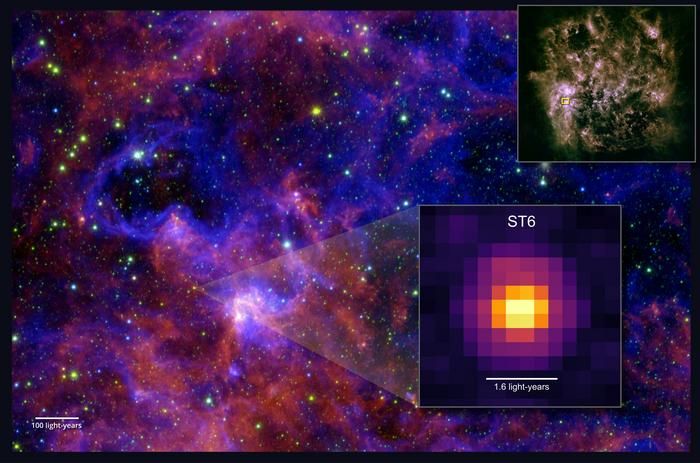Science
James Webb Space Telescope Detects Organic Molecules in Distant Galaxy

The James Webb Space Telescope (JWST) has made a groundbreaking discovery by detecting complex organic molecules (COMs) around a young protostar in the Large Magellanic Cloud (LMC), a dwarf galaxy approximately 163,000 light-years from Earth. This marks the first time such molecules have been observed in a galaxy beyond our Milky Way. The research, led by Marta Sewiło from the University of Maryland, utilized JWST’s Mid-Infrared Instrument (MIRI) to identify a variety of COMs encased in ice surrounding the protostar designated ST6.
COMs are defined as carbon-bearing molecules containing more than six atoms, and they include significant compounds such as acetaldehyde, acetic acid, ethanol, methanol, and methyl formate. Many of these molecules are essential precursors to the building blocks of life, including amino acids and RNA. The discovery of these frozen molecules not only enhances our understanding of star formation but also offers insights into the potential for life in the universe.
Significance of the Discovery
The identification of these COMs in their icy state is particularly noteworthy. While gas-phase COMs have been detected around young stars in both the Milky Way and the LMC, spotting them in their frozen phase presents substantial challenges. Sewiło noted that up to now, only four protostars in the Milky Way and one in the LMC—ST6—have shown evidence of icy COMs.
“We have only just started exploring the dependence of complex organic chemistry in this environment,”
Sewiło stated in an interview with Space.com. This discovery opens up new avenues for understanding the early stages of star and planet formation, especially in environments that differ significantly from our own galaxy.
The presence of these molecules around ST6 is especially intriguing due to the unique conditions of the LMC. This galaxy has a lower abundance of heavy elements compared to the Milky Way and is subject to a stronger ultraviolet radiation field. Such conditions can influence the abundance and formation of organic molecules.
Implications for Early Universe Chemistry
Understanding the organic chemistry of the LMC can provide valuable insights into the early universe, particularly regarding how quickly the building blocks of life could have formed. The discovery suggests that the dearth of heavy elements in the LMC has affected the abundance of COMs detected around ST6. According to Sewiło, “The COM ice abundances with respect to water ice that we measured for ST6 are lower than those measured for the four protostars in the Milky Way for all COMs, as expected, except for acetic acid.” The overabundance of acetic acid is likely due to the higher ultraviolet flux in the LMC.
At least 14 additional COMs were detected, though their identities remain unconfirmed. One possibility is glycolaldehyde, a precursor to ribose, which is an essential component of RNA. Sewiło indicated that conclusive evidence of glycolaldehyde is pending further laboratory spectra comparisons.
As ST6 evolves, the ice on its nearby dust grains will begin to sublimate, transitioning COMs into their gas phase. This transition is significant because it allows for more complex chemical reactions, potentially leading to the formation of larger molecules, including some that are vital for life.
The implications of this research are profound. It supports the idea that amino acids, which have been found in comets and meteorites within our solar system, may originate from similar pathways of chemical reactions that begin with the types of COMs discovered around ST6.
Published on October 20, 2023, in the Astrophysical Journal Letters, this research highlights the capabilities of the JWST in expanding our understanding of cosmic chemistry and the conditions that may lead to the origins of life.
-

 Science3 weeks ago
Science3 weeks agoInventor Achieves Breakthrough with 2 Billion FPS Laser Video
-

 Health3 weeks ago
Health3 weeks agoCommunity Unites for 7th Annual Into the Light Walk for Mental Health
-

 Top Stories3 weeks ago
Top Stories3 weeks agoCharlie Sheen’s New Romance: ‘Glowing’ with Younger Partner
-

 Entertainment3 weeks ago
Entertainment3 weeks agoDua Lipa Aces GCSE Spanish, Sparks Super Bowl Buzz with Fans
-

 Business3 weeks ago
Business3 weeks agoTyler Technologies Set to Reveal Q3 Earnings on October 22
-

 Health3 weeks ago
Health3 weeks agoCurium Group, PeptiDream, and PDRadiopharma Launch Key Cancer Trial
-

 World3 weeks ago
World3 weeks agoR&B Icon D’Angelo Dies at 51, Leaving Lasting Legacy
-

 Entertainment3 weeks ago
Entertainment3 weeks agoMother Fights to Reunite with Children After Kidnapping in New Drama
-

 Science3 weeks ago
Science3 weeks agoNorth Carolina’s Biotech Boom: Billions Invested in Manufacturing
-

 Health3 weeks ago
Health3 weeks agoNorth Carolina’s Biotech Boom: Billions in New Investments
-

 Entertainment3 weeks ago
Entertainment3 weeks agoRed Sox’s Bregman to Become Free Agent; Tigers Commit to Skubal
-

 Top Stories3 weeks ago
Top Stories3 weeks agoFormer Mozilla CMO Launches AI-Driven Cannabis Cocktail Brand Fast








